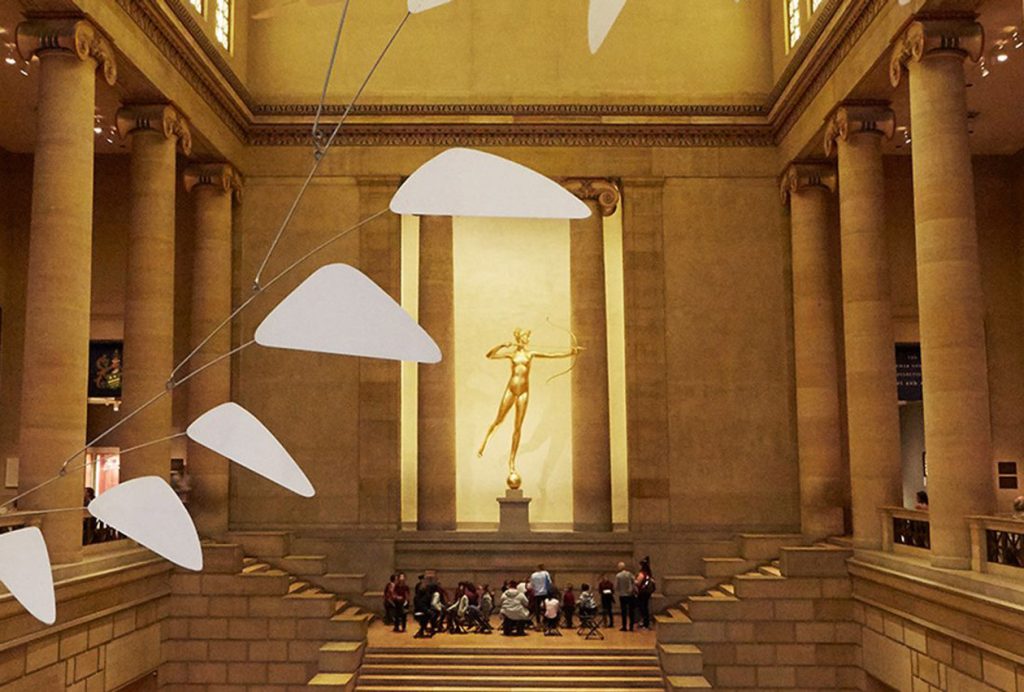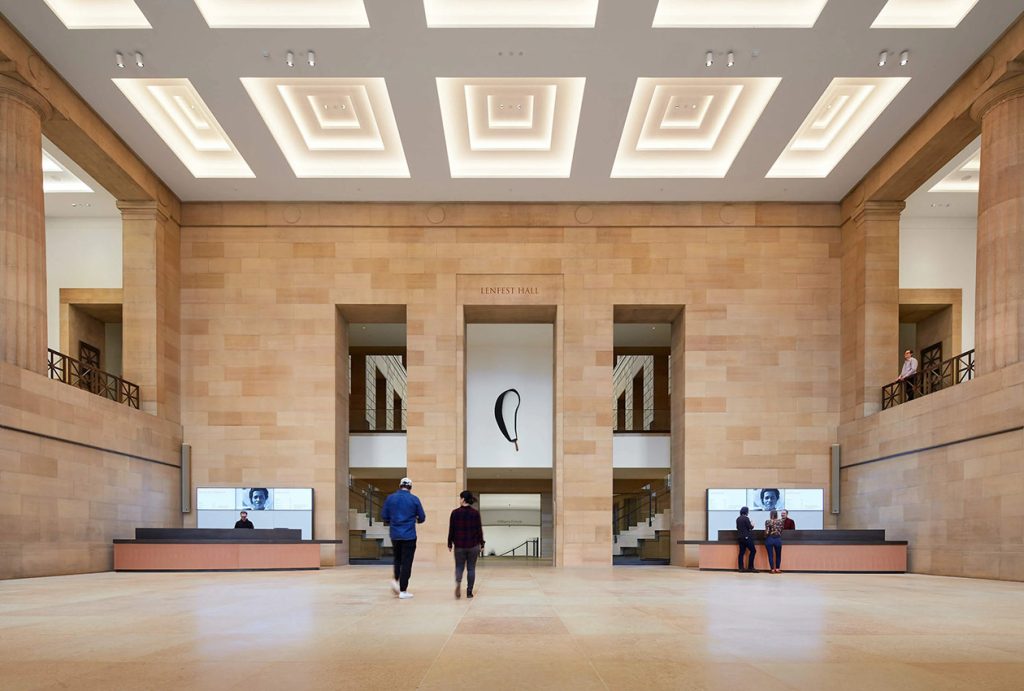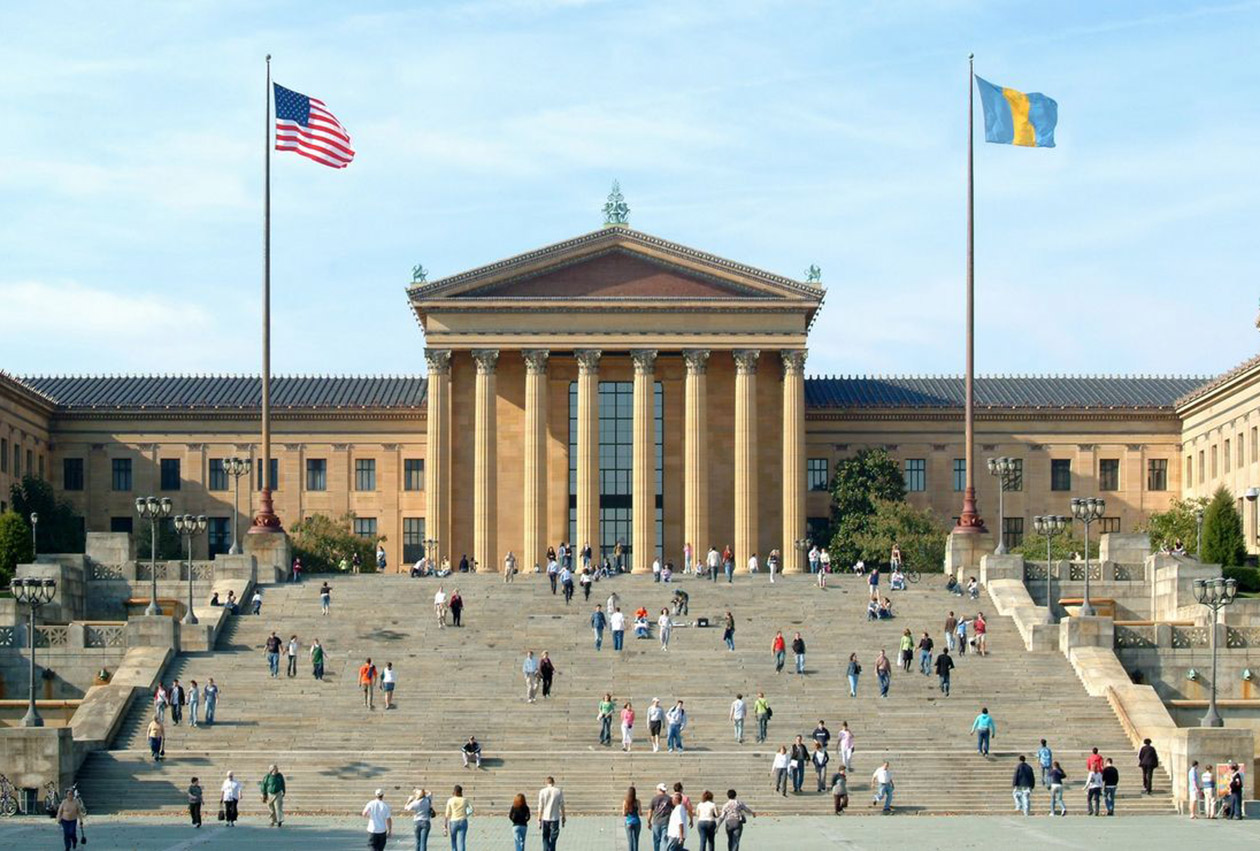I’m thrilled to share my art journey with you, diving into the heart of the Philadelphia Museum of Art (PMA). Whether you’re a seasoned art lover or a curious first-time visitor, the PMA offers a world of inspiration and wonder. I can confidently say that the PMA stands among the best.
This museum is not just a building filled with paintings, sculptures, and artifacts – it’s a true sanctuary for the soul. The exhibitions, the atmosphere, and the stories behind the art pieces made my visit not only educational but also transformative. With its breathtaking location atop the “Rocky Steps,” the museum offers more than a collection of art – it’s an immersive experience. From European masterpieces to contemporary innovations, the PMA has something for everyone.
I’ll take you on a journey through some of my favorite exhibits, featuring the iconic works that had me in awe. I’ll provide a detailed guide to each exhibition, recommend pieces to see, and offer practical advice on visiting the museum – from ticket prices to insider tips. Whether you’re planning your first visit or you’re a returning art aficionado, let’s dive into the art world of the Philadelphia Museum of Art!
1. The European Art Collection: A Time Travel Through History
Location: Philadelphia Museum of Art, 2600 Benjamin Franklin Parkway, Philadelphia, PA
Best Time to Visit: Weekdays, ideally in the morning to avoid the crowd.
Opening Hours: Tuesday to Sunday, 10:00 AM – 5:00 PM. The museum is closed on Mondays.
One of the most enchanting places in the museum is the European Art Collection. It covers an extensive period, ranging from the 12th century to the early 20th century, providing a perfect opportunity to “time travel” through art history. Walking through the grand halls, I found myself lost in centuries of creativity, each painting, each sculpture, and each piece telling a tale of human expression and emotion.
My Favorite Pieces:
- “The Wedding at Cana” by Paolo Veronese (1563)
The sheer grandeur of this masterpiece left me speechless. The vividness of the colors, the complex composition, and the incredible attention to detail in every figure and element of the scene overwhelmed me. Veronese’s ability to capture the opulence of the Venetian Renaissance is unmatched. Every time I looked at it, I noticed something new. - “The Hay Wain” by John Constable (1821)
The calm countryside of England is captured beautifully in this romantic landscape painting. The serenity of the scene and Constable’s mastery in blending the natural elements – the rolling hills, the misty sky, and the peaceful river – made me feel as though I could step right into the painting. - “The Blue Boy” by Thomas Gainsborough (1770)
This piece is an absolute icon of portraiture. The subject’s grace and elegance seem almost alive, and the blue satin outfit stands out with such vibrancy against the subtle, natural background. Every detail, from the folds of the clothing to the delicate expression on the boy’s face, showcases Gainsborough’s incredible skill.
Recommended Pieces:
- “The Lacemaker” by Johannes Vermeer
This quiet, intimate piece captures a moment of delicate craftsmanship, and Vermeer’s ability to bring light and life into an otherwise simple scene is remarkable. The subtle play of light and shadow on the subject’s face is simply mesmerizing. - “Venus and Mars” by Sandro Botticelli
This iconic Renaissance work brims with symbolism. The way Botticelli combines sensuality, myth, and nature within a single frame truly makes this painting a timeless masterpiece. - “Madonna and Child with Two Angels” by Fra Filippo Lippi
This is a stunning example of Renaissance religious art. The tender moment between mother and child, along with the heavenly golden light that bathes the figures, creates a feeling of divine grace.
My Personal Experience:
While the European art section is undoubtedly popular, I highly recommend taking your time and savoring the artworks at your own pace. The museum’s open and airy galleries make it easy to get up close and personal with the pieces. The lighting is designed to highlight the beauty of the art without overwhelming it, and I found myself spending hours just marveling at each piece. The museum staff are incredibly knowledgeable, and I had a chance to ask a curator about Veronese’s painting, which added a layer of richness to my understanding.
Ticket Prices and Discounts:
- General Admission: $20 for adults
- Seniors (65 and older): $18
- Students: $14
- Children under 12: Free
- Pay What You Wish: On the first Sunday of every month, and every Wednesday evening from 5:00 PM to 8:45 PM, visitors can pay what they wish for admission.
2. American Art Collection: A Glimpse into the National Soul

The American Art Collection at the PMA showcases works that reflect the spirit of the United States. From the 18th century to modern-day American art, this collection explores the country’s history through its changing cultural, political, and social movements.
My Favorite Pieces:
- “George Washington” by Gilbert Stuart (1796)
This portrait of America’s first president is an enduring symbol of the nation’s early years. Stuart’s meticulous detail and the dignified posture of Washington give the painting an almost larger-than-life quality. It’s one of the most iconic representations of leadership in American art. - “The Gross Clinic” by Thomas Eakins (1875)
One of the most striking and controversial works of art I’ve seen, Eakins’ painting depicts a surgical operation. The raw realism, coupled with the intensity of the subject matter, struck me deeply. It’s both disturbing and fascinating, shedding light on the advances in medical science in the 19th century. - “The Death of General Wolfe” by Benjamin West (1770)
This dramatic and emotional painting is not only a tribute to General Wolfe’s sacrifice but also a fantastic example of historical painting. West’s ability to convey the intensity of the battle and the moment of death while still infusing the painting with neoclassical dignity was stunning.
Recommended Pieces:
- “American Gothic” by Grant Wood
This iconic piece represents the Great Depression era in America. The stern, angular figures of the farmer and his daughter are a stark yet powerful reflection of rural America’s struggles during that time. - “The Daughters of Edward Darley Boit” by John Singer Sargent
This portrait showcases Sargent’s deft handling of light and texture. The four sisters are captured in a mysterious, almost haunting pose, and the unconventional composition makes this one of Sargent’s most intriguing works. - “The Wrestlers” by Thomas Eakins
Another amazing work by Eakins, “The Wrestlers” is both dynamic and full of energy, capturing the raw physicality and tension of a wrestling match. Eakins’ mastery in depicting human anatomy and movement is on full display.
My Personal Experience:
The American Art Collection spoke to me in ways I hadn’t expected. The works in this collection are deeply tied to the identity of the United States, and it was thrilling to walk through the various periods of American history, all told through art. I particularly enjoyed the mix of realism and romanticism in the paintings, which made me reflect on the changing notions of heroism, struggle, and triumph.
3. The Contemporary Art Collection: A Vision of the Now and Tomorrow
Location: Philadelphia Museum of Art, 2600 Benjamin Franklin Parkway, Philadelphia, PA
The contemporary wing of the museum is a breathtaking space filled with art that speaks to the present and future. It’s a place where boundaries are pushed, and new ideas emerge. The building itself is a modern masterpiece that contrasts beautifully with the older wings, and this space feels alive with innovation and energy.
My Favorite Pieces:
- “Big Self-Portrait” by Chuck Close (1967)
Chuck Close’s monumental self-portrait is a masterwork of photorealism, and seeing it in person is an awe-inspiring experience. The sheer scale of the piece, combined with the painstaking detail in every wrinkle and pore, left me utterly fascinated. - “For the Love of God” by Damien Hirst (2007)
A stunning work that is part sculpture, part philosophical commentary. The human skull encrusted with diamonds made me stop in my tracks – both for its beauty and its unsettling nature. It’s a piece that makes you think about mortality, materialism, and art all at once. - “The Dinner Party” by Judy Chicago (1974–1979)
This massive installation celebrates the contributions of women to history. The triangular table set with intricate place settings for 39 historical women blew me away. The attention to detail in each setting, as well as the symbolism in the artwork, was so moving that I stood there for much longer than I expected, contemplating its meaning.
Recommended Pieces:
- “Balloon Dog” by Jeff Koons
This playful and massive sculpture of a balloon dog in bright, reflective surfaces was one of the most exciting pieces I encountered. It feels almost cartoonish, but there’s a layer of complexity behind its cheerful facade. - “Untitled” by Mark Rothko
Rothko’s abstract works are always mesmerizing, and this large-scale piece was no exception. The colors seem to bleed into one another, creating an ethereal sense of movement. - “The Lights” by James Turrell
Turrell’s work is all about light and space. His installations often involve rooms that are lit with colored lights, and they invite you to step inside and experience the very perception of light itself. It was an experience unlike any other.
My Personal Experience:
The contemporary section felt like a breath of fresh air after the classical beauty of the earlier galleries. The freedom and innovation in the art made me feel as though I was engaging with the world of today. It was both challenging and exhilarating, as contemporary art often asks more questions than it answers. But I loved that feeling.
4. The Costume and Textile Collection: A Celebration of Fashion
Fashion and textiles are often overlooked in traditional art museums, but at the PMA, the Costume and Textile Collection is an absolute must-see. It houses more than 30,000 objects, ranging from clothing worn by 18th-century aristocrats to contemporary couture creations.
My Favorite Pieces:
- Marie Antoinette’s Dress
This historic piece left me completely in awe. The opulence of the gown and the intricate embroidery spoke volumes about the life of French royalty. Seeing it in person was like stepping into the past. - Dior Haute Couture Dress
A stunning example of mid-20th-century haute couture, this dress is the epitome of elegance. The sharp lines and luxurious fabrics were a testament to Dior’s genius. - Indian Saris
A collection of vibrant and ornate Indian saris stood out to me, showcasing the deep cultural significance of textile art. The colors, textures, and patterns were mesmerizing.
Recommended Pieces:
- 18th-Century European Court Dress
This piece perfectly encapsulates the elegance and grandeur of the period, with its intricate lacework and luxurious fabrics. - Victorian Wedding Gown
The attention to detail in the gown’s lace and beadwork was incredible, and it provided a fascinating insight into bridal fashion of the past. - Modern Evening Gown by Alexander McQueen
A stunning example of how modern fashion can still be rooted in the history of tailoring and technique.
My Personal Experience:
I’ve always been fascinated by fashion as an art form, and the museum’s Costume and Textile Collection was a dream come true for me. The pieces were not just clothing – they were works of art, each telling a story of its time. I was amazed at the level of craftsmanship involved in each piece and how fashion reflected the cultural shifts of the times.

Practical Information
Tickets and Discounts:
- General Admission: $20 for adults
- Seniors: $18
- Students: $14
- Children under 12: Free
- Group Discounts: Available for groups of 10 or more.
- Pay What You Wish: First Sunday of every month and Wednesday evenings (5:00 PM – 8:45 PM).
How to Get There:
- Public Transportation: The PMA is easily accessible via the SEPTA bus or subway. The museum is located at the end of the Benjamin Franklin Parkway, which is a pleasant walk from the Philadelphia Zoo and the Rodin Museum.
- Parking: There is a parking lot at the museum, though it can get crowded on weekends. Ride-share services are also convenient if you’re looking for door-to-door service.
Website for Tickets:
Tickets can be purchased on the Philadelphia Museum of Art’s official website, which also provides up-to-date information about exhibitions, special events, and hours of operation.
The Philadelphia Museum of Art is more than just a museum – it’s an immersive journey through the world of art. Each exhibit, each piece, and each gallery offers an opportunity to learn, reflect, and experience the beauty of human expression. Whether you’re a lover of classic art or modern pieces, the PMA offers something for everyone. So don’t just visit – immerse yourself in the art, explore every corner, and let the museum take you on an unforgettable journey!
